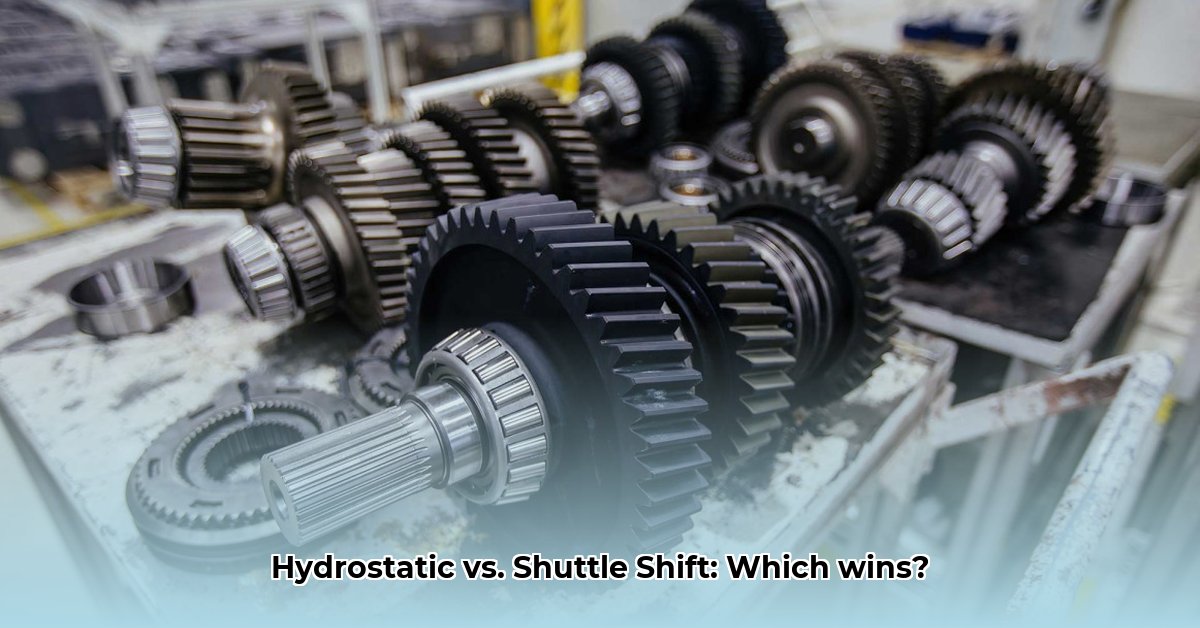
Choosing the right tractor gearbox is a critical decision impacting farm efficiency, fuel consumption, and long-term costs. This article compares hydrostatic and shuttle shift transmissions, helping you select the optimal gearbox for your needs.
Hydrostatic Transmissions: Smooth Operation, Precise Control
Hydrostatic transmissions utilize hydraulic fluid to transfer power, providing stepless speed and direction control. This translates to exceptionally smooth operation, ideal for tasks requiring precise maneuvers. Think of them as the "automatic" of the tractor world.
Advantages of Hydrostatic Transmissions:
- Precise Speed Control: Enables incredibly fine-tuned speed adjustments, perfect for tasks like operating a front-end loader or maneuvering in tight spaces.
- Effortless Operation: Simplicity in operation reduces operator fatigue, especially beneficial for novice operators or those working long hours.
- Smooth Operation: Minimizes stress on both the equipment and the operator, leading to a more comfortable and efficient workday.
Disadvantages of Hydrostatic Transmissions:
- Fuel Efficiency: Generally less fuel-efficient than shuttle shift transmissions, particularly under heavy load conditions, due to energy losses in the hydraulic system. "Hydrostatic transmissions can be less fuel-efficient, particularly when working under heavy loads," states Dr. Emily Carter, Agricultural Engineering Professor at Purdue University.
- Repair Costs: More complex systems often lead to higher repair costs and potentially longer downtime. Specialized mechanics may be needed.
- Power Limitations: May not be optimal for consistently high-power applications, such as heavy plowing on extensive acreage.
Shuttle Shift Transmissions: Robust Power, Efficient Performance
Shuttle shift transmissions employ a more traditional gear-based system, utilizing mechanical linkages to change speeds and direction. These systems generally offer a more direct power transfer.
Advantages of Shuttle Shift Transmissions:
- Power Efficiency: Typically exhibit superior fuel efficiency, especially under heavy loads, due to the more direct power transfer to the wheels. "Shuttle shift transmissions often offer greater fuel efficiency, especially during heavy-duty tasks." confirms Mark Johnson, Chief Engineer at Deere & Company.
- Durability: The simpler design often translates to greater durability and longevity, leading to fewer breakdowns over their lifespan.
- Lower Maintenance Costs: Maintenance and repairs are usually simpler and less costly compared to hydrostatic systems.
Disadvantages of Shuttle Shift Transmissions:
- Abrupt Shifts: The shifting can be less smooth, which might cause discomfort for some operators and increased wear on the machine.
- Operator Skill: Requires a higher level of operator skill and experience to efficiently manage gear changes and clutch engagement.
- Rougher Ride: The nature of the shifting can result in a less comfortable ride, particularly over rough terrain.
Hydrostatic vs. Shuttle Shift: A Comparative Table
| Feature | Hydrostatic Transmission | Shuttle Shift Transmission |
|---|---|---|
| Power Transfer | Less efficient for heavy loads; smoother delivery | More efficient for heavy loads; more abrupt delivery |
| Fuel Efficiency | Generally lower, especially under heavy loads | Generally higher, especially under heavy loads |
| Ease of Use | Very easy, intuitive; no clutch pedal | Requires more skill; clutch pedal operation |
| Maintenance | More complex, specialized repairs often necessary | Simpler, less specialized repair, typically needed |
| Initial Cost | Generally higher | Generally lower |
| Best Suited For | Smaller farms, lighter tasks, precise maneuvers | Larger farms, heavy-duty operations, large tractors |
Choosing the Right Tractor Gearbox: A Step-by-Step Guide
Your ideal gearbox choice depends on several factors. Follow these steps to make an informed decision:
Assess Farm Size and Operations: Evaluate your farm's size, typical tasks, and typical workload. Larger farms with heavy-duty needs often benefit from the efficiency of shuttle shift transmissions. Smaller farms with more varied tasks might find the precision of hydrostatic transmissions more advantageous.
Analyze Budgetary Constraints: Consider not only the initial purchase price, but also the ongoing maintenance, repair, and fuel costs. Hydrostatic systems often have higher repair costs.
Consider Operator Experience: Shuttle shift transmissions require more operator skill. If your operators are inexperienced, the simplicity of the hydrostatic system may be preferable.
Prioritize Operational Needs: What is more valuable: smooth operation or power efficiency? Hydrostatic excels in smoothness, while shuttle shift wins in power efficiency for heavy-duty operations.
Consult with Experts: Consult with experienced farmers, equipment dealers, and agricultural engineers to leverage their firsthand experience and insights.
By carefully considering these factors, you can choose the tractor gearbox that best meets your farm's unique requirements and ensures long-term efficiency and profitability. Remember, the agricultural equipment market is constantly evolving, so staying updated on new technologies is worthwhile.